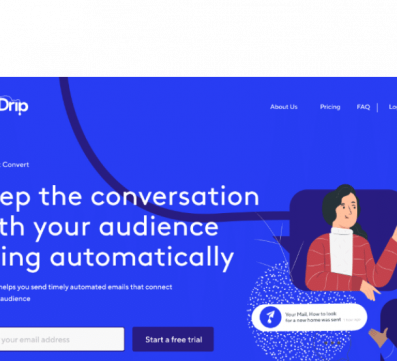
Is full-stack web development with Python complex for beginners? Do you have what it takes for full-stack web application development?
Building full-stack websites involves fusing back-end and front-end frameworks, which results in a feature-rich, responsive, and interactive web experience.
Full-stack developers are incredibly valuable because they can handle almost any aspect of web development from start to finish. Their versatility is a huge advantage.
This comprehensive article guides you on essential tasks to master in a full-stack web application. At the end, you will complete a tutorial and have the basic knowledge required to make a full-stack web application.
What Is Full-Stack Web Development?
Full-stack development covers everything involved in creating an application, from designing the user-friendly interface (front end) to building the behind-the-scenes systems (back end) that make it all work smoothly. The front end focuses on what users see and interact with, while the back end manages the logic, workflows, and data that power the application.
Full-stack developers are skilled in both areas, allowing them to create seamless, user-focused experiences and build strong, reliable back-end systems to support them.
RELATED POSTS:
- SIMPLIFY YOUR SITE WITH STATIC SITE GENERATORS
- 7 BEST BENEFITS OF A WEBSITE FOR SMALL BUSINESSES | Charisol
- 7 GAME-CHANGING UPDATES FOR FRONTEND DEVELOPERS
- MASTERING WCAG 2.1: A DEVELOPER’S GUIDE TO BUILDING ACCESSIBLE WEB EXPERIENCES
Essential Skills for Full-Stack Web Application Development
1. Learn the fundamentals of the front end
Think of a website’s front end as its public face—the part you see and use.
Full-stack developers use skills like HyperText Markup Language (HTML), Cascading Style Sheets (CSS), and JavaScript (JS) to make websites look good and work smoothly.
Learning new tricks and tools to create dynamic and engaging experiences is essential. These tools also ensure that websites look great on any device, from phones to giant screens.
Full-stack developers focus on creating easy websites for everyone, including people with disabilities.
They connect the front end (what you see) with the back end (the inner workings) so websites can load data quickly and seamlessly respond to your actions.
Learning the fundamentals of the front end will help you envision the interface of a website or app.
2. Learn a front-end framework
Choose the best combination of programming languages and tools for each project.
This allows you to create a customized ‘tech stack’ that works well together and aligns with the website’s specific requirements, ensuring compatibility and optimal performance.
Front-end development utilizes a range of programming languages and frameworks, including:
- Cascading Style Sheets (CSS) for styling and visual presentation
- HyperText Markup Language (HTML) to structure the web page content
- JavaScript (a versatile scripting language) that adds interactivity and dynamic behavior
- TypeScript (a superset of JavaScript) that involves static typing for improved code maintainability
- Popular frameworks:
- React: A JavaScript library for user interfaces
- Next.js: A React framework for building server-rendered and statically generated websites
- Vue.js: A progressive framework known for its flexibility and ease of use
These are important frameworks to learn and use as a full-stack developer.
3. Identify the basics of the back end
The back end is the unseen powerhouse of any website, handling all the behind-the-scenes work that makes it function.
Full-stack developers are experts in this area. They build the core systems using languages like Python, Ruby, PHP, and JavaScript (through Node.js). They manage data, integrate with databases, and ensure the website runs appropriately.
As a developer, you must learn to write clean, well-organized code that’s easy to maintain. Sometimes, depending on the project, you might need to adapt to different programming languages.
Ensure the back end is functional, reliable, and efficient. It should provide a strong foundation for the entire website.

Building Full-Stack Web Application with Python and Vue.js
Now, to the interesting part. It’s time to practice building a full-stack web application.
Before getting started, ensure you have the following installed on your system:
- Python: You can download and install Python from the official website (https://www.python.org/).
- Node.js and npm: Vue.js requires the installation of Node.js and npm. You can download and install them from the official website (https://nodejs.org/).
- Vue CLI: To scaffold Vue.js projects, install Vue CLI globally using npm by running the following command in your terminal or command prompt:
npm install -g @vue/cli
Setting up the Back End with Python
After installing the above requirements, use Flask, a web framework, to create your API.
Step 1: Create a project directory
Here, you will create a project directory for the back-end code. Open your terminal or command prompt and input the following command:
Step 2: Initialize a virtual environment
mkdir backend
cd backend
Initializing a virtual environment means isolating your Python development projects from the system installed in Python, including other Python environments and dependability.
Doing so gives you complete control of your project and makes it easily reproducible.
Execute the following command to achieve this:
Python -m venv venv
Step 3: Activate the virtual environment
For Windows:
venv\Scripts\activate
For macOS and Linux:
source venv/bin/activate
Step 4: Install Flask
The next step is to install Flask:
pip install Flask
Step 5: Create the Flask app
Create a file named app.py in the back-end directory, defining a Flask application:
app.py
from flask import Flask
app = Flask(__name__)
@app.route(‘/’)
def hello():
return ‘Hello from Flask!’
Step 6: Run the Flask app
Run the Flask app using the command below:
python app.py
You should see the following output:
* Running on http://127.0.0.1:5000/ (Press CTRL+C to quit)
This means your Flask back end is up and running on http://127.0.0.1:5000/.
Setting up the Front End with Vue.js
After completing the back end, set up the front end using Vue.js.
Step 1: Create a Vue.js project
- Open your terminal or command prompt.
- Navigate to your project’s root directory (where the back-end directory is located).
- Run the following command to create a new Vue.js project:
vue create frontend
This will prompt you to pick a preset. Choose the default preset (or manually select features as needed).
Step 2: Run the Vue.js development server
After the Vue.js project is created, navigate to the front-end directory and run the development server using the following command:
cd frontend
npm run serve
You should see the following output:
App running at:
– Local: http://localhost:8080/
– Network: http://192.168.0.101:8080/
Now, your Vue.js frontend is running on http://localhost:8080/
Step 3: Update Vue.js to fetch data from the back end
Update the Vue.js app to get data from the Flask back end you initially created.
Open the frontend/src/App.vue file and replace its content with the following:
<template>
<div>
<h1>{{ message }}</h1>
</div>
</template>
<scipt>
export default {
data() {
return {
message: “”,
};
},
mounted() {
fetch(“http://localhost:5000/”)
.then((response) => response.text())
.then((data) => {
this.message = data;
});
},
};
</script>
This code will fetch data from the Flask back end and display it in the Vue.js app.
Connecting the Back End and Front End
Now that both the back end and front end are set up, the next step is to link them so that the front end can communicate effectively with the back end API.
In the frontend/src/App.vue file, you are fetching data from the back end using the URL http://localhost:5000/, where the Flask back end is running.
Since the Vue.js development server runs on a different port (by default, it’s http://localhost:8080/), you need to configure Vue.js to proxy API requests to the Flask back end during development.
Step 1: Configure Vue.js Proxy
Create a file named vue.config.js in the front-end directory (if it doesn’t exist already) and add the following content:
module.exports = {
devServer: {
proxy: {
‘/api’: {
target: ‘http://localhost:5000’,
changeOrigin: true,
},
},
},
};
Step 2: Update the Vue.js app to use Proxy
Update the fetch URL in the frontend/src/App.vue file to use the /api prefix, which will be automatically proxied to the Flask back end during development:
<template>
<div>
<h1>{{ message }}</h1>
</div>
</template>
<script>
export default {
data() {
return {
message: “”,
};
},
mounted() {
fetch(“/api”)
.then((response) => response.text())
.then((data) => {
this.message = data;
});
},
};
</script>
Step 3: Restart the Vue.js development server
Restart the Vue.js development server by stopping it (if it’s running) using CTRL+C and then running npm run serve again.
When you visit http://localhost:8080/, the Vue.js app should fetch data from the Flask back end and display it on the page.
Building a Simple To-Do List Website Using Python and Vue.js
After the installation, development, and connection phases are complete, add a simple feature to the full-stack web application to illustrate how to build and integrate features using Python and Vue.js.
This feature will be a simple to-do list app where users can add and remove tasks.
The tasks will be stored in the back end using a list, and Vue.js will handle the front end to display and manage them.
To do this, we will begin with the back-end implementation:
Step 1: Modify the back-end API
In the app.py file (in the back-end directory), update the back-end API to handle tasks.
Add the following code:
from flask import Flask, jsonify, request
app = Flask(__name__)
tasks = []
@app.route(‘/api/tasks’, methods=[‘GET’])
def get_tasks():
return jsonify(tasks)
@app.route(‘/api/tasks’, methods=[‘POST’])
def add_task():
data = request.get_json()
task = data.get(‘task’, ”)
tasks.append(task)
Return jsonify({‘message’: ‘Task added successfully!’})
@app.route(‘/api/tasks/<int:index>’, methods=[‘DELETE’])
def remove_task(index):
if 0 <= index < len(tasks):
del tasks[index]
return jsonify({‘message’: ‘Task removed successfully!’})
else:
return jsonify({‘error’: ‘Invalid index!’}), 400
Note: In this updated API, we have three endpoints: GET /api/tasks to retrieve all tasks; POST /api/tasks to add a new task, and DELETE /api/tasks/<int:index> to remove a task by its index.
Step 2: Update the Vue.js app
In the frontend/src/App.vue file, modify the Vue.js app to display the tasks and add the functionality to ‘add and remove’ tasks.
Replace its content with the following code:
<template>
<div>
<h1> Charisol’s To-Do List</h1>
<div v-for=”(task, index) in tasks” :key=”index”>
{{ task }}
<button @click=”removeTask(index)”>Remove</button>
</div>
<input v-model=”newTask” @keydown.enter=”addTask” placeholder=”Add a new task” />
<button @click=”addTask”>Add</button>
</div>
</template>
<script>
export default {
data() {
return {
tasks: [],
newTask: “”,
};
},
mounted() {
this.fetchTasks();
},
methods: {
fetchTasks() {
fetch(“/api/tasks”)
.then((response) => response.json())
.then((data) => {
this.tasks = data;
});
},
addTask() {
if (this.newTask.trim() !== “”) {
fetch(“/api/tasks”, {
method: “POST”,
headers: {
“Content-Type”: “application/json”,
},
body: JSON.stringify({ task: this.newTask }),
})
.then(() => {
this.newTask = “”;
this.fetchTasks();
});
}
},
removeTask(index) {
fetch(`/api/tasks/${index}`, {
method: “DELETE”,
})
.then(() => {
this.fetchTasks();
});
},
},
};
</script>
Finally, your app is ready!
This Vue.js app displays the to-do list, allows users to add new tasks by typing in the input field and hitting “Enter” or clicking the “Add” button, and provides a “Remove” button for each task to delete it.

Conclusion
Full-stack web application development is like building a house. You must design the outside (front end), build the foundation, and implement the inner workings (back end).
The front end is what users see and interact with, while the back end powers everything behind the scenes. Together, they create a complete and functional website or application.
Follow the step-by-step tutorial in this article to successfully build a full-stack web application using Python as the back-end language and Vue.js as the front-end framework.
At Charisol, our expert team builds robust, responsive website and app development that bolsters your needs. Contact us today!
READ ALSO: THE FUTURE OF IOT: HOW EDGE COMPUTING IS LEADING THE CHARGE (2025)



